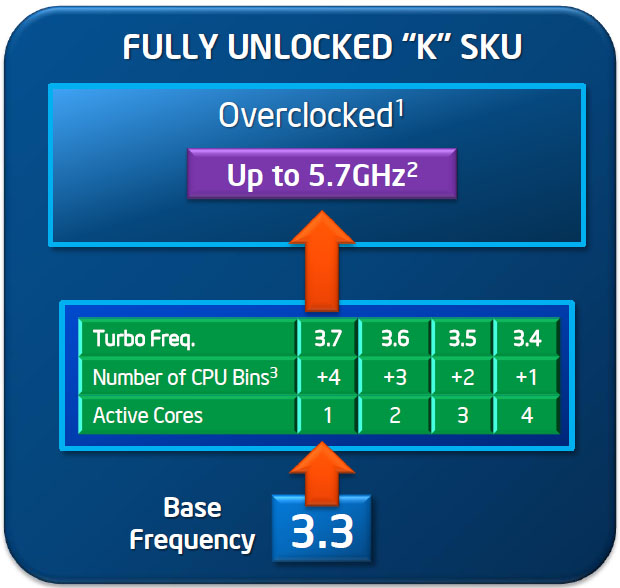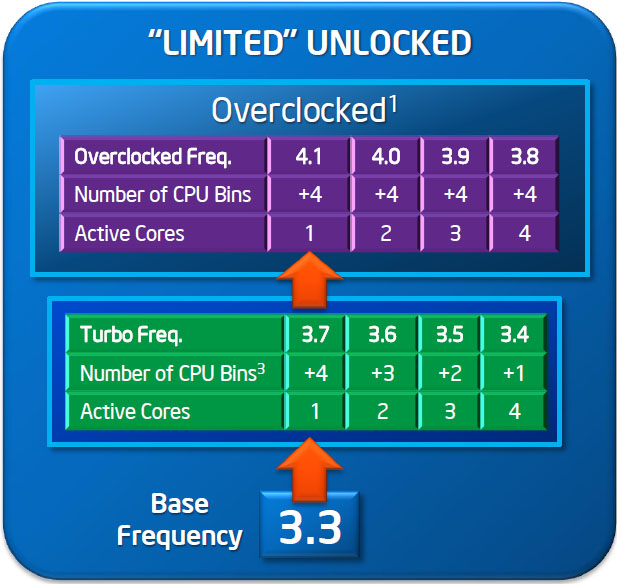Intel’s Second-Gen Core CPUs: The Sandy Bridge Review
Although the processing cores in Intel’s Sandy Bridge architecture are decidedly similar to Nehalem, the integration of on-die graphics and a ring bus improves performance for mainstream users. Intel’s Quick Sync is this design’s secret weapon, though.
Overclocking: Sandy Bridge Changes The Game
As you probably already know, Sandy Bridge dramatically alters the way enthusiasts can approach overclocking. For a great many, the days of wringing massive gains out of a scalable architecture like Nehalem are over. Options do still exist, though.
The back-story is already pretty well known. In an effort to simplify its design (which really does make sense from an engineering perspective), Intel integrated the clock generator into the 6-series chipsets. Now, one clock affects the entire system, meaning you can’t independently set the frequencies of various subsystems like PCI Express and the DMI.
Unfortunately, PCI Express doesn’t like to operate very far outside of its specification, so any significant deviation beyond the new 100 MHz BCLK causes problems. Though there’s generally a few percentage points worth of wiggle room, the days of taking Nehalem’s 133 MHz BCLK up to 200+ MHz are history. Overclockers are basically losing one of the two variables that previously affected processor performance. Intel addresses this in two ways.
First, it carries over the unlocked K-series that first surfaced back in May of last year. These parts top out at a 57x ratio multiplier, enabling frequencies of up to 5.7 GHz without touching the BCLK. Intel says the 57x is largely a “design consideration,” whatever that means. The good news for the LN2 crowd is that the company is working on a BIOS that’ll go higher and apply to today’s CPUs. The K-series chips also offer "unlocked" DDR3 memory ratios, which aren't literally unlocked, but rather exposed up to DDR3-2133 (higher than most kits are capable of going anyway). Power and current limits can also be custom-specified, too.
There are only two K-series parts at launch: the Core i7-2600K and the Core i5-2500K. The unlocked i7 costs $23 more than the partially-unlocked version of the same chip, while the i5 runs $11 more expensive than its less-flexible equivalent. When you consider that, at its default settings, the Core i5-2500K runs at 3.3 GHz and Turbo Boosts up to 3.7 GHz, compared to the Core i5-760 at 2.8 GHz, an unlocked Sandy Bridge chip for $11 extra is actually pretty damn sexy.
If you don’t buy a K-series chip and instead grab a Core i7-2600, Core i5-2500, -2400, or -2300 (along with a P67-based motherboard), you’ll still have access to “limited unlocking.” This basically means you can set clock rates up to four speed bins above the highest Turbo Boost frequency setting available at any given level of processor activity.
So, take a Core i7-2600 as an example. The chip’s base clock is 3.3 GHz. With four cores active, it gets one bin worth of additional performance—3.4 GHz. Four bins above that would be 3.8 GHz. With two cores active, Turbo Boost bumps it up two bins, to 3.5 GHz. Limited overclocking makes 3.9 GHz available in that case. In a best-case scenario, only one core is active. Turbo Boost adds four bins of frequency, yielding 3.7 GHz, and Intel’s overclocking scheme lets you run at up to 4.1 GHz.
Get Tom's Hardware's best news and in-depth reviews, straight to your inbox.
Anyone with a K-series CPU overclocking on air is going to be in good shape. Thomas and I both have Core i7-2600Ks that’ll do 4.7 GHz at 1.35 V all day long. More mainstream folks with non-K i5s and i7s will at least have an extra 400 MHz to milk from their chips. It’s the value-oriented buyers with processor budgets between $100 and $150 (where AMD offers some of its best deals) who get screwed. The only two Sandy Bridge-based options under $175 are the Core i3-2100 and -2120 at 3.1 and 3.3 GHz, respectively. No Turbo, no BCLK option, no limited unlock—those chips are quite literally stuck.
As with the integrated graphics situation, I think that Intel missed the boat by trying to use overclocking as a differentiating feature. The guys who hit 7 GHz+ in our recent K-series overclocking contest are getting artificially capped. The folks buying at the bottom end of the mainstream stack can’t touch their BCLK or multiplier settings. And unless you buy one of two K-series SKUs, you’re on a Turbo Boost + 400 MHz leash.
Hopefully AMD is taking notes. Though most of its newest 45 nm processors don’t offer a ton of headroom, sticking 32 nm manufacturing later this year could make flexible Bulldozer-based CPUs very attractive to anyone who feels like Intel is muscling them out of overclocking at the high- and low-end.
Current page: Overclocking: Sandy Bridge Changes The Game
Prev Page Two New Platforms, More On The Way Next Page Meet Intel’s Second-Gen Core CPUs-
cangelini MoneyFace pEditor, page 10 has mistakes. Its LGA1155, not LGA1555.Reply
Fixed, thanks Money! -
juncture "an unlocked Sandy Bridge chip for $11 extra is actually pretty damn sexy."Reply
i think the author's saying he's a sexually active cyberphile -
fakie Contest is limited to residents of the USA (excluding Rhode Island) 18 years of age and older.Reply
Everytime there's a new contest, I see this line. =( -
englandr753 Great article guys. Glad to see you got your hands on those beauties. I look forward to you doing the same type of review with bulldozer. =DReply -
joytech22 Wow Intel owns when it came to converting video, beating out much faster dedicated solutions, which was strange but still awesome.Reply
I don't know how AMD's going to fare but i hope their new architecture will at least compete with these CPU's, because for a few years now AMD has been at least a generation worth of speed behind Intel.
Also Intel's IGP's are finally gaining some ground in the games department. -
cangelini fakieContest is limited to residents of the USA (excluding Rhode Island) 18 years of age and older.Everytime there's a new contest, I see this line. =(Reply
I really wish this weren't the case fakie--and I'm very sorry it is. We're unfortunately subject to the will of the finance folks and the government, who make it hard to give things away without significant tax ramifications. I know that's of little consolation, but that's the reason :(
Best,
Chris -
LuckyDucky7 "It’s the value-oriented buyers with processor budgets between $100 and $150 (where AMD offers some of its best deals) who get screwed."Reply
I believe that says it all. Sorry, Intel, your new architecture may be excellent, but unless the i3-2100 series outperforms anything AMD can offer at the same price range WHILE OVERCLOCKED, you will see none of my desktop dollars.
That is all.


